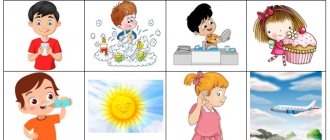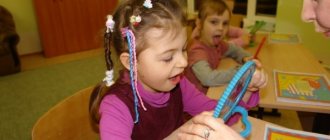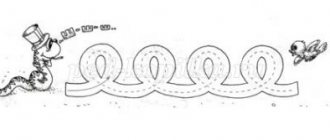Setting the sound [T] with a softening defect
Soft phonemes are characterized by a high elevation of the back of the tongue towards the hard palate. The softening defect appears due to increased muscle tone. The nature of the defect is influenced by the location of the lesion in the cerebral cortex.
An increase in the muscle tone of the tongue causes it to tense, pull back, and the tip is not pronounced. To eliminate this disorder, speech therapy exercises are used: hill, angry cat, frog. Their goal is to ensure plasticity of the middle part. In difficult situations, you should rely on tactile sensations - place your middle and index fingers on your tongue to feel relaxation when moving from a soft sound to a hard one.
It is necessary to demonstrate the difference in the position of the tongue in front of the mirror and ask to repeat the position. Then the child reproduces paired syllables with hard and soft phonemes after the adult. If the solid sound is reproduced correctly, it is advisable to immediately begin pronouncing words.
Correct articulation of the “T” sound
To pronounce “T” clearly, you need to:
- slightly open your lips and teeth;
- rest your tongue on the upper front incisors;
- raise the soft palate;
- pay attention to the fact that the air stream should be jerky;
- don't turn on your voice.
When pronouncing a soft “T”, the curved back of the tongue rests on the alveoli of the upper teeth with its front part, and its tip is located at the lower incisors.
The reasons that the sound “T” is pronounced incorrectly when the formation of the speech apparatus is completed may be a violation of the muscle tone of the organs of articulation or difficulties in differentiating with other sounds.
How sound is produced
When pronouncing [T], the articulatory organs are in the following position: the lips stretch slightly, the teeth open, the tip of the tongue connects with the upper incisors, the air stream is sharp, breaks the bow, there is no voice.
In the initial position, the lips should open slightly, the gap between the dental rows is approximately 3-5 mm. The tip of the tongue hits the upper alveolar process, connecting with it. When playing [T], the soft palate rises, the vocal folds separate, and the air flow is jerky. The sound [T] is consonant, hard, occlusive, anterior lingual, explosive, noisy, deaf.
Preparatory stage for sound production [T]
Speech therapy work on the production of any sound traditionally contains four stages: preparatory, actual production, automation, differentiation. The lesson begins with the characteristics of articulation. Be sure to use a variety of visual material: picture plan, articulation profiles, manual articulation model, dummies, pictures.
The child examines the position of the articulatory organs and determines the nature of the air flow. Then, with the help of an adult, he analyzes the sound according to the following algorithm: vowel or consonant (whether there is an obstacle to the exhaled air flow), dull or voiced (whether the vocal cords tremble), hard or soft (whether the middle part of the back rises to the hard palate).
After becoming familiar with the characteristics of sound, you need to start performing articulatory gymnastics:
- Fence. The teeth are clenched tightly, the lips stretch into a wide smile. Hold this position for about ten seconds.
- Arrow. The front edge of the tongue moves very quickly to the left and right from one corner of the lips to the other.
- Flatbread. The spread out wide tongue is located on the relaxed lower lip.
- Naughty tongue. Open your mouth as much as possible. Place your flat tongue on your lower lip and say “five-five-five” while slapping your upper lip.
- The escape. Push your tongue between your closed teeth.
- Brush. Use the narrow tip of the tongue to make sliding movements along the upper incisors, moving to the alveolar processes.
- Camel. Suck up the candy with the tip of your tongue, click at the same time, then spit out the candy with the wide tip.
In addition to articulation exercises, gymnastics involves performing breathing exercises:
- Football player. Open your mouth very strongly, pull out the flat tip of your tongue, and with a sharp exhalation, blow a light ball into the toy gate.
- Sailor. Using jerky short exhalations, push the paper boat into a container of water.
Automation and differentiation of sound [T]
After the child has been able to correctly pronounce [T], it is necessary to move on to automating it - reinforcing the correct pronunciation. Automation should begin with the development of phonemic hearing - the perception of phonemes by ear. The child is asked to isolate a sound from a number of phonemes that are similar in acoustic-articulatory characteristics; isolate it from a series of syllables; isolate a sound from a series of words; determine its presence and location in a word. At the beginning of automation and with an insufficient level of speech development, it is necessary to start with sounds that are distant in acoustic-articulatory characteristics.
Then they move on to automating the phoneme in isolated form. It is practiced with a sharp exhalation using onomatopoeic games.
Then you need to introduce the child to the letter that represents the sound [T] in the letter. Explain how a sound differs from a letter: a sound is heard and spoken, but a letter is seen, written and read. They select objects from the surrounding world that look like the letter T.
If necessary, the correct spelling of the letter is practiced. A variety of graphic exercises are used, aimed at developing hand motor skills and training in obtaining an adequate image of a letter. When a child speaks the sound [T] well in isolation, the automation of phonemes in syllables, in words, in sentences, in coherent speech begins.
After automating the sound, they move on to its differentiation - distinguishing it from other sounds. It is carried out by analogy with automation: in isolation, in syllables, words, sentences, coherent speech. First, sounds that are distant in acoustic-articulatory characteristics are differentiated, ending with phonemes that have similar sound and articulation. The production of the sound [T] is considered complete if the child always pronounces [T] accurately, including in spontaneous speech.
Defects in the pronunciation of the sound [T]
- Distortion . Instead of [T], a sound is heard that has no analogue in the native language. Nasal pronunciation of phonemes in rhinolalia.
- Absence (elision) . The articulatory structure of the phoneme is not completely formed. Occurs in severe forms of cleft palate in the case of rhinolalia.
- Replacement . [T] is replaced by another phoneme, similar in acoustic-articulatory parameters, most often by the back-lingual phoneme [K]. With rhinolalia, a replacement with pharyngeal pronunciation is observed.
- Mixing . In isolation [T] is pronounced correctly, but in spontaneous speech it is replaced by another phoneme.
- Mitigation . Replacement of hard [T] with soft [Ть], undifferentiated use of these phonemes.
- Vocalization defect . The child does not deafen the sound enough. His sonorous pair [D] can be heard in his speech.
Features of pronunciation of sounds T D
What typical mistakes do children make when pronouncing them? Systematically occurring speech disorders include:
- Replacing the front-lingual sounds “T – D” with the corresponding back-lingual “k – g”, for example, “k( t )igrenok”, “ing( d )yuk”.
- Mixing the front-lingual consonants “T – D” with the back-lingual “k – g”: cell - cell; glass - rolled.
- The sound “T” can be softened by “P” or “K”, for example: pichka - bird; drink, drink instead of dot.
- Persistent confusion T H (u t it - teaches, nine ( h)ka), T Ts (Pet ya - Petya, blooms - blooms).
In children with speech errors, one can observe the following construction of sentences: “Mom, where (where) are my tanfettes (sweets)?”, “There are sweets on the tartine (picture). Others immediately notice such violations, and parents may also detect incorrect articulation of the sound t : instead of leaving the tip of the tongue below, resting on the front teeth, the baby raises it to the palate.
Very often the reasons for incorrect pronunciation are:
- Disturbances in articulation (function of the speech organs).
- Low mobility of the lower jaw.
- Underdevelopment of auditory perception (the baby cannot distinguish sounds).
- It’s a bad example for adults when someone around them pronounces T D .
In any case, the diagnosis is made by a speech therapist, and parents are engaged in making sounds at home in accordance with his recommendations. Articulation gymnastics is very helpful in work, which should become a constant companion not only in classes, but also in everyday life.
Important: correction of the pronunciation of sounds N T D, as a rule, is carried out after simple sounds are clearly defined in the preschooler’s speech: vowels (a, u, o, i, e, s) and consonants (b b, p p, m m, v v, f f).
To examine the pronunciation of T D , you can offer your child a small test in the form of several exercises:
- Following the adult, pronounce sentences in which these sounds occur, for example: Dusya gives melon to Dasha. Aunt Tanya has notebooks on the table.
- Look at pictures that depict objects with sounds T D , for example: slippers, calf, tiger, axe, TV, cart, cake; melon, house, door, tree, girl, children.
- Among the pictures laid out on the table, find the one that the adult names: dot - daughter, cloud - dacha, duck - pipe, pond - twig, house - volume.
Work is required for the child whose speech cannot be traced with TD or is replaced by other sounds, and there is no differentiation (distinguishing sounds that are similar in sound).








